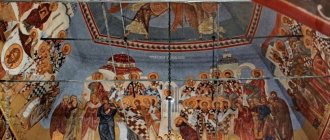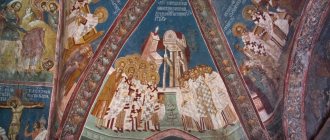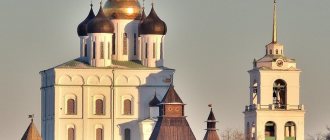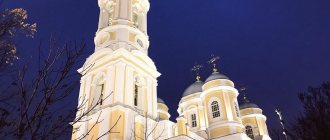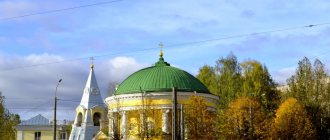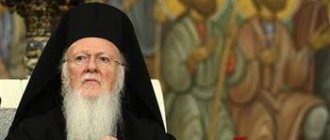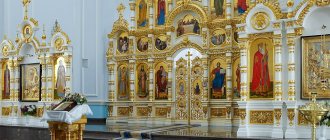In the 8th century, the heresy of iconoclasm began to spread in Byzantium. The first persecutor of icon veneration was the emperor Leo the Isaurian (717,741), who was absolutely ignorant of church affairs. He decided that the destruction of the veneration of icons would return to the Empire the regions it had lost, and that Jews and Mohammedans would become closer to Christianity.
As a result, a view arose, supported by many statesmen of the empire and clergy, of icon veneration as idolatry.
At the same time, the overwhelming majority of the Church Fathers opposed this. They were persecuted and many died as martyrs. Saint Irene put an end to this strife by restoring the veneration of icons at the VII Ecumenical Council.
The Seventh Ecumenical Council was convened against the heresy of iconoclasm
The Seventh Ecumenical Council (also known as the Second Council of Nicaea) was convened in 787, in the city of Nicaea, under Empress Irene (widow of Emperor Leo Chosar). It consisted of 367 bishops, representing mainly the eastern part of the church, and legates of the Pope. The council was convened against the heresy of iconoclasm, which appeared 60 years before it, under the Byzantine emperor Leo the Isaurian.
Thus, he wanted to remove obstacles to peaceful coexistence with Muslims and therefore decided to abolish the veneration of icons. The iconoclasts continued their activities under his son Constantine Copronymus and grandson Leo Khozar.
. Photo: drevo-info.ru
VII Ecumenical Council. Icon. The Seventh Ecumenical Council was convened against the heresy of iconoclasm
It should be noted that one of the reasons for convening the VII Ecumenical Council was the fact that earlier the Iconoclasts would have convened the Iconoclast Council (Council of Hieria). This is a meeting of the highest clergy of the Christian church, held in 754 in the palace of Hieria, on the Asian shore of the Bosphorus, between Chalcedon and Chrysopolis (Scutari).
It was convened by the Emperor of Byzantium, Constantine V. The iconoclasts raised the question that worshiping the image on the icon is a pagan custom. The following dogmas were approved at the council:
- Icons were commanded to be revered as idols.
- All those who worshiped icons were anathematized, including Patriarch Herman of Constantinople.
787
this year the Seventh Ecumenical Council was convened
The Seventh Ecumenical Council was attended by 338 bishops of the Christian Church in the East. Thus, almost all the famous representatives of the Orthodox Church of that time were present here.
Among them, icon venerators were not represented; these were iconoclast bishops who took the place of displaced icon venerators, or bishops who received departments specially created for them.
It should be noted that at the Council many of them renounced iconoclasm and turned to orthodox Christianity with repentance.
Leo III the Isaurian and his son Constantine V. Byzantine Emperor Leo III the Isaurian is the first emperor to support the Iconoclast heresy. His son Constantine V continued to support her. Photo: upload.wikimedia.org
In the Orthodox Church, the memory of the holy fathers of the Seventh Ecumenical Council is celebrated on Sunday, falling at the end of the 1st ten-day period or the beginning of the 2nd ten-day period of October (according to the Julian calendar).
The Holy Fathers of the 7th Ecumenical Council are represented on a separate icon. It is also worth noting that the painting of the Seventh Ecumenical Council belongs to the pen of such a famous artist as Salvador Dali.
Literature
- Memories of the Seventh Ecumenical Council // Lives of the Saints in Russian, set out according to the guidance of the Chetyih-Menya of St. Demetrius of Rostov: 12 books, 2 books. add. - M.: Moscow. Synod. typ., 1903-1916. — Vol. II: October, Day 11. — P. 250.
- Asmus V.V., prot.
The Seventh Ecumenical Council of 787 and the power of the emperor in the Church // Regnum Aeternum. - 1996. - No. 1. - P. 47-68. - Dil Sh.
Empress Irina // Byzantine portraits / trans. from French M. Bezobrazova. - M.: Art, 1994. - P. 62-82. - Zaitsev D.V., N.L.
Jonah // Orthodox Encyclopedia. - M., 2011. - T. XXV: “John’s Acts - Joseph Shumlyansky.” - pp. 434-437. — 752 p. — 39,000 copies. — ISBN 978-5-89572-046-2. - Kartashev A.V.
VII Ecumenical Council of 787 // Ecumenical Councils. - Klin: Christian Life Foundation, 2002. - pp. 574-679. — 679 p. - Lozinsky S. G.
Chapter II. Formation of the Papal State (VI-VIII centuries) // History of the Papacy. - M.: Publishing House of Political Literature, 1986. - 384 p. — (Library of atheistic literature). - Firsov E.V.
Acts of the Second Nicene (Seventh Ecumenical) Council (787) - St. Petersburg: Nestor-Istoriya, 2016. - 596 p. — 500 copies. — ISBN 978-5-4469-0891-2. - Tsypin V., prot., Asmus V., prot.
Ecumenical Council VII // Orthodox Encyclopedia. - M., 2005. - T. IX: “Vladimir Icon of the Mother of God - The Second Coming.” — P. 645-660. — 752 p. — 39,000 copies. — ISBN 5-89572-015-3.
The preparations for the Seventh Ecumenical Council were led by Empress Irina
At the end of 783, the Byzantine Emperor Leo IV died suddenly. His widow, Empress Irene, prevented a plot in favor of Nikephoros, her husband's half-brother, and concentrated all power in her hands.
This allowed her, as an opponent of the heresy of iconoclasm, to begin to resolve issues of convening a Council that could condemn her. To do this, Empress Irene had to organize the election of a new Patriarch of Constantinople instead of the deceased Patriarch Paul.
Before his death, he abdicated the throne and retired to a monastery, regretting his involuntary complicity in iconoclasm and advising to convene an Ecumenical Council to eliminate the schism of the Church.
Saint Tarasius, Patriarch of Constantinople. The election of the layman Tarasius to the patriarchal throne was caused by the need to place at the head of the Church a state administrator who was not involved in the heresy of iconoclasm
Instead of Patriarch Paul, the imperial secretary (asikrit) Tarasius, known for his learning, was elected.
The election of a layman to the Patriarchate was caused by the need to place at the head of the Church not only a learned theologian who was not involved in iconoclasm, but also a sensible statesman, whose help Irina needed in restoring church peace.
Tarasius agreed to take the see of Constantinople only after the emperor and empress publicly spoke out in favor of holding an Ecumenical Council, despite the discontent of certain individuals from the “people” (obviously, the military).
At Christmas 784 St. Tarasius was elevated to the highest level of the church hierarchy.
One of the fathers, Saint Tarasius, was Patriarch of Constantinople for 22 years.
Tarasius remained Patriarch of Constantinople for 22 years. The elected patriarch, according to tradition, sent out a statement of his religion to all heads of churches.
Additionally, invitations to the Ecumenical Council were sent out, written on behalf of Irina, her son Emperor Constantine and Tarasius himself. An invitation was also sent to Pope Adrian I in Rome to take part in the upcoming Council.
Adrian I, Pope of Rome. Engraving (Sacchi P. Vitis pontificum. 1626). Pope Adrian I was invited to the Seventh Ecumenical Council and sent two of his legates to it
Pope Adrian I responded with 2 messages dated Oct. 26. 785, in which the idea of the primacy of the Roman Church was pursued with particular persistence.
The pontiff stated that he considered it possible to restore the veneration of icons only on the basis of patristic tradition, an excerpt from which he cited in his letter.
There, the pope appointed two legates to the Council: presbyter Peter and abbot Peter, and also named Irina and her son the new Constantine and the new Helen. Seeing the zeal for the Orthodoxy of the Empress and Patriarch, Adrian agreed to hold the Council subject to the following conditions:
- the solemn anathematization of the iconoclastic council of 754 in the presence of papal legates;
- provision by the Empress, Patriarch and Senate of a written guarantee of the inviolability of papal legates;
- the return to the jurisdiction of the Roman Church of the regions of Southern Italy previously transferred by Emperor Leo III the Isaurian to the jurisdiction of the Patriarchate of Constantinople;
- non-use of the title “ecumenical” by the Patriarch of Constantinople.
The Seventh Ecumenical Council lasted a month and consisted of eight meetings
In May 787, Irina again sent out invitations asking her to come to the Council in Nicaea. The composition of the delegations remained virtually unchanged. From Rome there were the same legates; the three eastern patriarchs, who were unable to come because of the wars with the Arabs, were represented by their sinkels John and Thomas.
In total, according to various estimates, 350 - 368 hierarchs were present at the Council, but the number of signatories of its Act was 308 people. The Seventh Ecumenical Council opened on September 24 and lasted a month.
Empress Irina with her son at the Seventh Ecumenical Council (fresco by Dionysius, 15th century). Empress Irina took part in the final 8th meeting of the Council. Photo: upload.wikimedia.org
Empress Irene was not personally present in Nicaea; she was represented by the committee of Petron and the chief of staff John. The council held 8 meetings, the last of which took place on October 23, 787 in Constantinople in the presence of Irene and the emperor, her son.
The Council began its work by making a decision regarding the iconoclast bishops, many of whom were allowed to participate in the work of the Council, accepting their public repentance. And only at the fourth meeting, at the suggestion of the papal legates, was the icon brought to the temple where the Council met
"Monk in Pants"
But most importantly, politicians took up arms against the icon-worshippers, blaming the “clerical” regime for the ignorance of the people. The “cancellation” of icons was no longer enough for them - they started talking about the secularization of all church property.
In the 60s of the 8th century, persecution of monks and monasteries began - as supposedly hotbeds of icon veneration, and at the same time, forges of “church workers” cadres. Things were moving almost towards the complete abolition of monasticism. The iconoclasts behaved harshly: monks were forced to dress in light clothes and marry, and those who refused were blinded and exiled, sometimes even executed. Monasteries were confiscated, barracks were set up for soldiers, or simply destroyed.
In the provinces, the initiators of the persecution were the authorities, but in the capital, the crowd incited by them was rampaging.
Executions of monks (miniature from the Chronicle of John Skylitzes, early 13th century)
At the Seventh Ecumenical Council, an oros was adopted, which restored the veneration of icons
As a result of the work of the Seventh Ecumenical Council, the Oros was adopted. Oros of the 7th Ecumenical Council restored the custom of venerating icons and allowed the use in churches and homes of icons of the Lord Jesus Christ, the Mother of God, Angels and Saints, honoring them with “reverent veneration”:
...like the image of the honest and life-giving Cross, to place in the holy churches of God, on sacred vessels and clothes, on walls and on boards, in houses and on paths, honest and holy icons, painted with paints and made of mosaics and other suitable substances , icons of the Lord and God and Our Savior Jesus Christ, our immaculate Lady, the Holy Mother of God, as well as honorable angels and all saints and reverend men.
For, the more often they are visible through the image on icons, the more those who look at them are encouraged to remember the prototypes themselves (των πρωτοτύπων) and to love them and to honor them with kisses and reverent worship (τιμητικήν προσκύ νησιν), not the same true service according to our faith (λατρείαν), which befits only the Divine nature, but veneration according to the same model as it is given to the image of the honest and life-giving Cross and the Holy Gospel, and other shrines, incense and lighting candles, as was done according to pious custom and ancient.
For the honor given to the image goes back (διαβαίνει) to the prototype, and the one who worships (ο προσκυνών) the icon worships (προσκυνεί) the hypostasis of the person depicted on it.
Iconoclastic Cathedral (miniature from the Khludov Psalter).
The Seventh Ecumenical Council canceled the decisions of the Iconoclastic Council and adopted an oros restoring the veneration of icons and anathematism regarding them. Photo: upload.wikimedia.org Thus, the iconoclastic heresy was condemned. For this purpose, the Council also adopted anathematism regarding holy icons:
- If anyone does not confess that Christ our God is represented by humanity, let him be anathema!
- If anyone does not accept the artistic depiction of Gospel scenes, let him be anathema!
- If anyone does not welcome such images, existing in the name of the Lord and His saints, let him be anathema!
- If anyone rejects any written or unwritten church tradition, let him be anathema!
Recommendations
- ^ a b
Gibbon, p.1693 - Council of Hieria, Canon 19: “If anyone does not accept this Holy and Ecumenical Seventh Synod of ours, let him be anathema to the Father and the Son and the Holy Spirit, and from the seven holy Ecumenical Synods!” https://www.fordham.edu/halsall/source/icono-cncl754.asp
- Warren T. Threadgold (1997). History of the Byzantine State and Society
. Stanford University Press. p. 388. ISBN 978-0-8047-2630-6. Retrieved January 27, 2013. - Ostrogorsky, p.178.
- Gibbon, p.1693.
- Ostrogorsky, p.178
- "NPNF2-14. The Seven Ecumenical Councils are an ethereal library of Christian classics.” www.ccel.org
. - Hussey, J. M. (1986). The Orthodox Church in the Byzantine Empire
. Oxford and New York: Oxford University Press. pp. 49–50. - Wed John Calvin, Institutes of the Christian Religion 1.11
- See: https://www.knigafund.ru/books/12281/read
- See: N. Tanner, "Atti del Concilio Niceno Secondo Ecumenico Settimo, Tomi I – III, Introduction e traduzione di Pier Giorgio Di Domenico, saggio encomiastico di Crispino Valenziano", in "Gregorianum", N. 86/4, Rome, 2005, paragraph 928.
- Catholic Church, Atti del Concilio Niceno Secondo Ecumenico Settimo (Citta del Vaticano: Libreria Editrice Vaticana, 2004) ISBN 9788820976491
- ISBN 9785446908912
Sources
- Calvin, John, Institutes of the Christian Religion
(1559), translated by Henry Beveridge (1845). Peabody: Hendrickson, 2008. - Gibbon, Edward. Decline and Fall of the Roman Empire
. New York: Random House Inc., 1995. ISBN 0-679-60148-1 - Ostrogorsky, Georgy. History of the Byzantine State
. New Brunswick: Rutgers University Press, 1969. ISBN 0-8135-0599-2 - Raab, Clement. Twenty Ecumenical Councils of the Catholic Church
, 1937. - This article incorporates text from a publication now in the public domain: Jackson, Samuel McAuley, ed. (1914). “The title of the article is required.” The New Schaff–Herzog Encyclopedia of Religious Knowledge
(third ed.). London and New York: Funk and Wagnalls.
Today the dogma of icon veneration of the fathers of the Seventh Ecumenical Council is in effect.
The Fathers of the Seventh Ecumenical Council are today revered by local Orthodox churches. This is how the dogma of the veneration of icons of the Three Hundred and Sixty-seven Saints was adopted by the father of the Seventh Ecumenical Council. After its closure, the bishops were dispersed to their dioceses with gifts from Irene.
The Empress ordered the image of Jesus Christ to be made and placed above the gates of Chalcopratia to replace the one destroyed 60 years ago under Emperor Leo III the Isaurian. An inscription was made to the image: “[the image], which was once overthrown by the ruler Leo, was again installed here by Irina.”
Fathers of the Seventh Ecumenical Council, icon. In the Orthodox Church, the memory of the holy fathers of the Seventh Ecumenical Council is celebrated on Sunday, falling at the end of the 1st ten-day period or the beginning of the 2nd ten-day period of October (according to the Julian calendar). Photo: bolshoi-zlatoust.ru
The decisions of the council caused outrage among the Frankish king Charlemagne (the future emperor), and in 792 he sent the pope a list of 85 mistakes that were made at this council. After him, a dispute began about the essence of the Holy Spirit. The fact is that Karl did not agree with the expression of Patriarch Tarasius:
“The Holy Spirit proceeds from the Father through the Son,” and insisted on another formulation: “The Holy Spirit proceeds from the Father and from the Son.”
Since the words “and from the Son” sound filioque in Latin, further disputes on this issue came to be called the filioque controversy. In his response to Charles, the pope sided with the council.
The Frankish king Charles did not recognize the decisions of the Seventh Ecumenical Council.
The Council and the Fathers, unfortunately, were unable to stop the movement of the iconoclasts. This was done only at the Council of Constantinople in 843 under the Empress Theodora. At the same time, the acts of the Ecumenical Councils and their holy fathers had a significant impact on the Orthodox Creed.
Thanks to them, the veneration of saints, their iconographic images, and holy relics spread throughout the Orthodox world. After the Seventh Ecumenical Council, icons of angels and saints were recognized, which the Third Ecumenical Council and the Fifth Ecumenical Council could not achieve. It must be remembered that this is the last world Council recognized by the Orthodox Church.
By leaving a comment, you accept the user agreement
Notes
- Kartashev. Ecumenical Councils, 2002, p. 577.
- ↑ 1 2 Theophanes the Confessor.
l. m. 6277, R.H. 777 // Chronography. - Kartashev. Ecumenical Councils, 2002, p. 613.
- Kartashev. Ecumenical Councils, 2002, p. 615-617.
- Irina refused to grant this request from her father.
- Kartashev. Ecumenical Councils, 2002, p. 622.
- Lynda Garland.
Constantine VI (780-797 AD) and Irene (797-802 AD) (English) (2002). - Kartashev. Ecumenical Councils, 2002, p. 619.
- Kartashev. Ecumenical Councils, 2002, p. 624.
- ΘΕΟΛΟΓΙΑ ΤΗΣ ΕΙΚΟΝΑΣ - ΑΙΡΕΤΙΚΕΣ ΑΠΟΚΛΙΣΕΙΣ 25η 25η 2010 )
- Sacrorum conciliorum nova et amplissima collectio. Tomus 13 col. 378
- Dogma of the Three Seth of the Sixty-Seventh Century of the Seventh Ecumenical Council, No. // Book of Rules of the Holy Apostles, Saints of ecumenical and local councils, and holy monks. - Reprint. playback ed. 1893 - Sergiev Posad: Publishing house. Holy Trinity Sergius Lavra, 1992.
- Dogma on the veneration of icons to the Three Hundred and Sixty-seven Saints, father of the Seventh Ecumenical Council (unspecified)
(inaccessible link). Access date: September 29, 2008. Archived June 19, 2008. - Definition of the Holy Great and Ecumenical Council, the second in Nicaea (Acts of the Ecumenical Councils, published in Russian translation at the Kazan Theological Academy. - Kazan: Central Printing House, 1909. - T. 7. - P. 284–285. - 332+iv p. ).
- The Russian translation is based on the book: Kartasheva A.V.
Ecumenical Councils. - The inscription is based on a play on words Λέων - lion, predatory beast
and Ειρήνη -
peace, tranquility.
